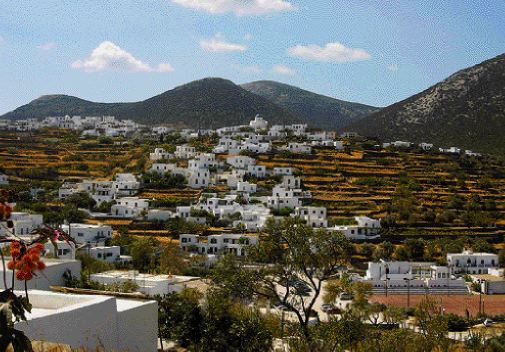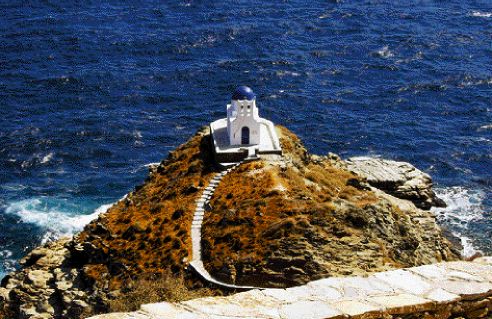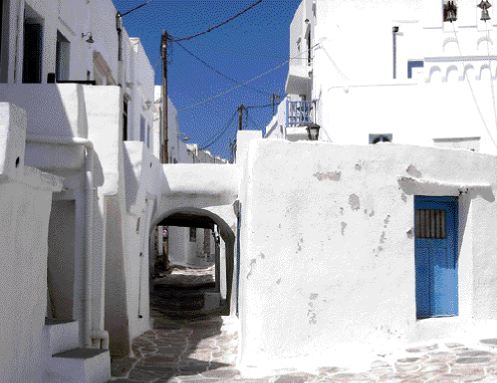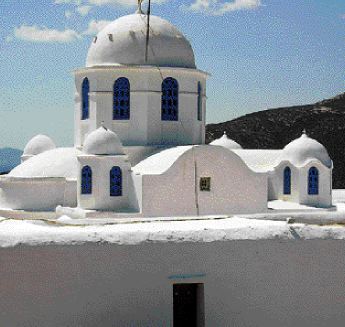 |
||
|
Sifnos: A Love Story
|
||
|
Apart from being spotlessly clean, the birthplace of Tselementes lures visitors with its olive-sprinkled hills, sugar cube houses and picturesque churches By Diana Farr Louis |
 All of Sifnos' main villages meander across the hills like white rivers |
|
| You can't point to one single thing that wows you with its magnificence, but after a while you realise that just about everything fits without a single, jarring note. And the place has crept into that warm and fuzzy area you call your heart. We would never have gone back to Sifnos, located in the western half of the Cyclades, had it not been for a surprise wedding invitation received in the middle of May. Along with the announcement came a website and a warning to book early for September since Vathy had only a few rooms that weren't reserved by returnees a year in advance. Apart from a very expensive resort, that is, way out of our reach. Vathy? I remembered it as a rather melancholy bay shaped like a frying pan with a narrow entrance, a few potters' sheds, a small church and perhaps one taverna. We'd anchored there twice on the way back from cruises with friends. Then it was "sleep after toyle, port after stormie seas" but not much else. It did not seem to have changed much between the late 1970s and late 1990s, so I wondered what could have happened in the meantime. |
||
We picked up a car at Kamares, the port, from Dimitris at Apollo Rental. A passionate historian of his adopted island, he told us that the church of the Taxiarch, where the wedding would take place, was built "in the sea because that was where the Archangel insisted on having his icon" and that it had been a meeting place of the Filiki Etairia - would-be revolutionaries plotting the overthrow of the Turks in the early 19th century. He also cautioned us not to stray from the asphalt roads and that there would be little need to do so, since the island's road network was so good. |
 A solitary chapel below the Kastro |
|
| A quick glance at Kamares told us that the port had expanded on both sides but that there still was no real reason to linger, despite the pleasant beach and plethora of eateries. It's almost a rule, in the Cyclades at any rate, that the main harbour is the least interesting and least attractive settlement on the island. On Sifnos, Kamares is also the most recent. The drive up the cleft in the mountains above it brought us to the plateau where the island's twin capitals sit, or rather, sprawl over tawny, olive-sprinkled hills. Named after the gods born to Leto on Delos, Apollonia and Artemonas merge seamlessly with five other villages whose borders are known only to postmen. Their white, sugar-cube houses meander this way and that, punctuated here and there by the cerulean domes of the larger churches and the occasional splash of green trees or vermilion bougainvillaea. Never has sprawl looked so ordered. Dry-stone walls divide the land into arable strips as evenly spaced as the lines on a score of music, sparing not an inch, no matter how steep, below the boulder line - you can hardly speak of the timber line in the Cyclades - on Sifnos' jagged mountains. Furthermore, white bubbles glisten from practically every one of those pointed spurs. You'll find a chapel dedicated to the Prophet Elijah (Elias in Greek) on the highest peak of any island, but Sifnos boasts five of them: O Psilos, O Hamilos, O Kontos - the High, the Low, the Short - and two more, in addition to summit shrines dedicated to other holies. |
||
In fact, on Sifnos, churches pop up everywhere - at the bottom of gullies, on sea-battered rocks, joined to houses like Siamese twins, in villages, in fields, on beaches... There are said to be 366 of them and I spotted one more under construction. Seafarers built the smaller ones in hopes of winning divine protection on the high seas. Houses and churches alike have the soft lines and rippled surfaces that come from decades, if not centuries, of whitewash. And there is not an ugly building on the island. Even the new houses, and plenty are going up, conform to local tradition. This is nothing short of a miracle in today's Aegean, where three-storey villas and prefab chapels are changing the landscape. |
 Inside the mediaeval Kastro, Sifnos' capital until 1836 |
|
What's more, Sifnos is spotlessly clean. In four days of exploring, I saw no roadside litter, no abandoned water bottles, no plastic bags waving from thistles. Part of the responsibility goes to the mayor, who has been in office for 15 years and has a vigilant garbage collection squad. But part of the reason for the islanders' love of cleanliness may lie buried in antiquity. In pre-Classical times up to the 5th century BC, Sifnos was fabulously wealthy. Its mines produced tonnes of silver and even some gold. The treasury the Sifnians donated to the Oracle at Delphi is still one of the wonders there. Besides that, their wealth was such that every year they donated a giant solid-gold egg to the oracle. They basked in the gods' favour until the year they substituted a gilded egg. Outraged, the oracle lashed out, cursing them and their descendants for being unclean. Some say the Sifnians have been trying to atone ever since, trying to wash away the stain on their reputation. Naturally, I could find no one to corroborate this theory. Kastro's rings Traces of ancient Sifnos are mainly confined to remnants of watchtowers, of which an astonishing 55 have been recorded, the foundations of a Cycladic/Classical settlement at Agios Andreas, and the original walls of the mediaeval Kastro, on a cliff above the rocky east coast. Kastro and Agios Andreas were the sites of two of the island's three acropolises. Kastro, which was the island's capital until 1836, is one of those places I love to wander through but would dread to live in. It is built in two concentric rings on the top of a bluff. The aristocracy, headed by the da Corogna family, Venetian vassals originally from Catalonia, resided in relative comfort in the inner circle. The poor lived in the outer ring in houses that formed a fortress-like continuous wall with practically no windows and only three tunnel-like entrances, which could be easily defended against pirates. |
||
| These houses may have been Greece's first blocks of flats. Space was at such a premium that ownership was apportioned horizontally, by floor, rather than vertically. The lanes between the rings - some of them roofed to create crosswalks - are barely wide enough for a donkey, especially when half-blocked by the odd Roman sarcophagus. Frankish escutcheons over doorways, recycled fluted columns and precipitous views of a wave-lashed chapel way below help to dispel feelings of claustrophobia and inconvenience. I thought of lugging gas bottles and watermelons up the path to one's picturesque abode. Although only 47 people are hardy enough to live there year-round, many more have done up places for summer use. |
 Panagia tou Vounou is one of the island's prettiest churches |
|
| "Living here is tough, but you get used to it, " said the barman at the Remezzo terrace, who prepared a lemonade with margarita finesse. "I've carried unbelievable stuff up here, and look how fit and slim I am." Weight watchers, take up residence in the Kastro. You can always allow yourself an occasional reward at the Konaki sweet shop near the entrance. Sifnian gems Panagia tou Vounou is one of the island's prettiest churches Good food is another Sifnian obsession. After all, it was the birthplace of Tselementes, Greece's first modern cookbook writer, and Sifnos accounts for a hefty portion of the country's chefs. For some reason, the islanders are passionate about chickpeas. Their most famous dish, revithada, slow-baked chickpeas, is featured on almost every taverna menu, along with fritters, revithokeftedes. But there are so many other tempting specialities that ordering can be difficult. On the other hand, many of the sweets are almond-based, produced in such quantities that homegrown almonds no longer suffice. We happily devoured almond cakes, biscuits and several variations of amygdalota, the crushed almond pyramids found around the Aegean. The best are reputedly made at Theodorou's in Artemonas, worth a visit because it cannot have changed much since it opened in 1933. Its doors and shelves are still painted that hospital-waitingroom-green so typical of bygone rural Greece. Tradition also thrives in Sifnos pottery. Almost every house has a multi-spouted clay pot atop its chimney, every serving of revithada comes in a pretty glazed tsikali (sic) or casserole, and potters ply their ancient trade in dozens of workshops round the island. Some still use a foot-operated wheel. Their output includes a good deal of modern kitsch but they have by no means renounced classic shapes and designs. In the days before plastics and cheap metal, Sifnian potters supplied much of Greece with all that a kitchen needed, not to mention flowerpots. When times were hard in Sifnos, many of them moved to Maroussi, where the clay was similar, and turned that former village into the country's largest pottery centre. One thing Sifnos lacks is divine beaches. In their place it has several small sandy bays hemmed with tamarisk trees that obviate the need for umbrellas. The biggest, grandly named Wide Beach (Platys Yialos), attracts the most tourists while remaining faithful to the low-key island style. Others like Faros in the south and Herronisos in the north are backed by clusters of houses that have remained fishing hamlets. But even if relatively empty, they all boast at least one old-fashioned taverna, where you can sit at the water's edge and bathe between mezedes. Which brings us back to Vathy. At first we were put off by having to park in an olive grove about 8 minutes' walk from our room and drag our suitcases over the sand. But once unencumbered, what a relief it was to be free of cars and motorbikes and just two steps from the water. In a few moments I was transported in time back to the 1960s, when my life in Greece was a simple barefoot affair and I rarely wore more than a bathing suit. The road to Vathy is relatively recent and only the beach, the colour of Sifnos pots, connects the small pensions, five tavernas and three mini-markets on its rim. The church - in reality a tiny monastery - must indeed have sat in the sea originally. Now it's surrounded by a cement floor that doubles as a pier where yachts tie up. It is pleasingly unsymmetrical, with double domes that don't quite match and a slightly off-centre belfry. Children scramble over its courtyard walls, sunbathers loll in front of it. But if the right side of Vathy wallows contentedly in the past, the left side lures you into the future. At the far end of the beach, where the sand is blonder and more copious, the Elies Resort is one of the most tasteful, elegant complexes I've seen. You don't know it's there until you're standing in front of it. Although it did not open until 2003, mature Mediterranean plants and vines surround the 30 or so gleaming white or stone rooms and suites, arranged on terraces up the hill and focused on a magnificent pool. Of course, that's superfluous right next to the sea, but it does make a luxurious setting for a celebration, for two or 100. On Saturday evening all the guests gathered there to walk the groom to the church. A trio of local musicians fiddled and piped us down the beach, while the rest of Vathy - tourists and Sifnians - lined up to ogle and grin at the unlikely parade. For though we were dressed to the nines, we were clutching our sandals in our hands. The barefoot wedding party rinsed our feet at a tap near the church, where towels were thoughtfully provided, and slipped on our shoes to await the bride. That night all Vathy rocked with our festivities, but two evenings later the Taxiarch church hosted its own panigyri - with cauldrons of revithada and beef stew, wine and dancing for as many on the island who cared to come. These saints' day celebrations are legendary in Sifnos and with so many churches, the chances of missing one are slight. Disappointed, I turned to my travel companion. "You know," he said, "I really like it here. Why don't we come back next year and rent a room in Artemonas?" Sifnos had captured us both. * How to get there The ferry takes about 51/2 hours from Piraeus, while a high-speed craft takes about 2½ to 3½ hours, depending on whether they stop at Serifos. You can also island-hop to or from most of the islands visible from Sifnos: Milos, Folegandros, Paros, Naxos, Mykonos and more * Where to stay (area code 22840) For the well-heeled, Elies Resort at Vathy has to be the island's nicest hotel, but room/suite rates start at about 200 euros and go up to 1,500 euros (-33151 or book online). Otherwise, Vathy has several simpler apartment complexes that are comfortable enough, spotlessly clean and two steps from the beach. We stayed at Xanthakis (-31971, 6944-449782) and Calypso nearby looked welcoming (-32043). At Ano Petali, closer to Apollonia than Artemonas, the Petali Village would be a pleasant in-town residence (-33024). You can view all these places at www.greeka.com/cyclades/sifnos/hotels or Google them * Where to eat We stumbled upon Lembessis taverna on the beach at Apokoftou between Chryssopighi, Sifnos' most celebrated church, and Faros. Our Greek guidebook proclaims it the best on the island and we kept going back to try more of the dishes on their huge menu. At Vathy, To Tsikali is the best taverna on the water, while Livadi, near the carpark, was recommended by locals. Liotrivi, at the entrance to Artemonas, is also well known for its Sifnos specialities. But on this island of cooks, you're likely to eat well almost everywhere. Be warned though, fresh fish do push up the prices. And for the yummiest cakes, biscuits and coffee in Apollonia, don't miss the Gerontopoulos sweetshop |
||
|
|
||
|
|
||
(Posting Date 3 May 2007) HCS readers can view other excellent articles by this writer in the News & Issues and other sections of our extensive, permanent archives at the URL http://www.helleniccomserve.com./contents.html
All articles of Athens News appearing on HCS have been reprinted with permission. |
||
|
||
|
2000 © Hellenic Communication Service, L.L.C. All Rights Reserved. http://www.HellenicComServe.com |
||

